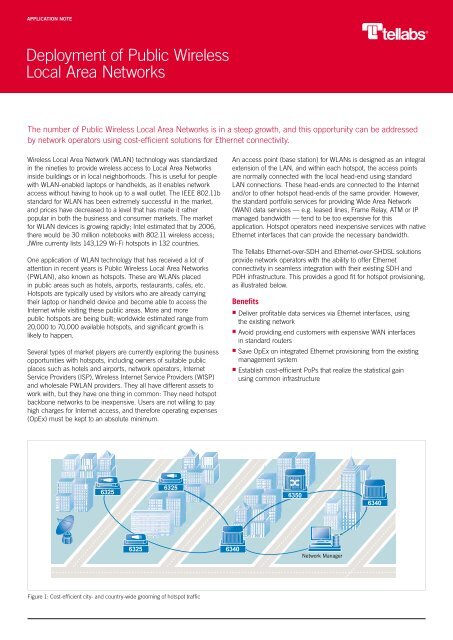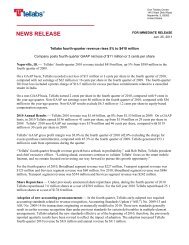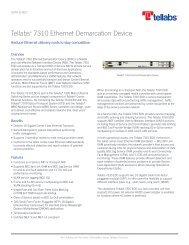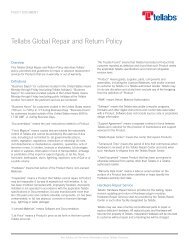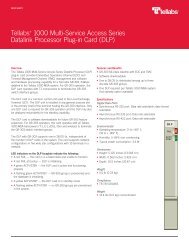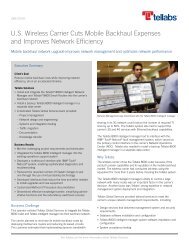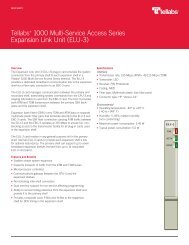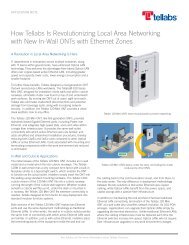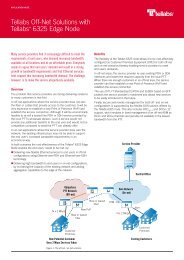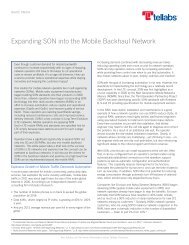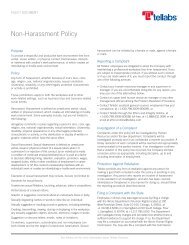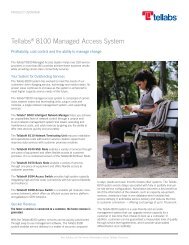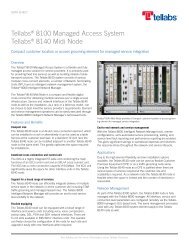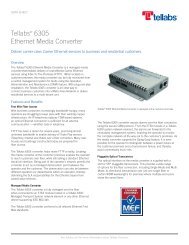Deployment of Public Wireless Local Area Networks - Tellabs
Deployment of Public Wireless Local Area Networks - Tellabs
Deployment of Public Wireless Local Area Networks - Tellabs
Create successful ePaper yourself
Turn your PDF publications into a flip-book with our unique Google optimized e-Paper software.
APPLICATION NOTE<br />
<strong>Deployment</strong> <strong>of</strong> <strong>Public</strong> <strong>Wireless</strong><br />
<strong>Local</strong> <strong>Area</strong> <strong>Networks</strong><br />
The number <strong>of</strong> <strong>Public</strong> <strong>Wireless</strong> <strong>Local</strong> <strong>Area</strong> <strong>Networks</strong> is in a steep growth, and this opportunity can be addressed<br />
by network operators using cost-efficient solutions for Ethernet connectivity.<br />
<strong>Wireless</strong> <strong>Local</strong> <strong>Area</strong> Network (WLAN) technology was standardized<br />
in the nineties to provide wireless access to <strong>Local</strong> <strong>Area</strong> <strong>Networks</strong><br />
inside buildings or in local neighborhoods. This is useful for people<br />
with WLAN-enabled laptops or handhelds, as it enables network<br />
access without having to hook up to a wall outlet. The IEEE 802.11b<br />
standard for WLAN has been extremely successful in the market,<br />
and prices have decreased to a level that has made it rather<br />
popular in both the business and consumer markets. The market<br />
for WLAN devices is growing rapidly; Intel estimated that by 2006,<br />
there would be 30 million notebooks with 802.11 wireless access;<br />
JWire currenty lists 143,129 Wi-Fi hotspots in 132 countries.<br />
One application <strong>of</strong> WLAN technology that has received a lot <strong>of</strong><br />
attention in recent years is <strong>Public</strong> <strong>Wireless</strong> <strong>Local</strong> <strong>Area</strong> <strong>Networks</strong><br />
(PWLAN), also known as hotspots. These are WLANs placed<br />
in public areas such as hotels, airports, restaurants, cafés, etc.<br />
Hotspots are typically used by visitors who are already carrying<br />
their laptop or handheld device and become able to access the<br />
Internet while visiting these public areas. More and more<br />
public hotspots are being built; worldwide estimated range from<br />
20,000 to 70,000 available hotspots, and significant growth is<br />
likely to happen.<br />
Several types <strong>of</strong> market players are currently exploring the business<br />
opportunities with hotspots, including owners <strong>of</strong> suitable public<br />
places such as hotels and airports, network operators, Internet<br />
Service Providers (ISP), <strong>Wireless</strong> Internet Service Providers (WISP)<br />
and wholesale PWLAN providers. They all have different assets to<br />
work with, but they have one thing in common: They need hotspot<br />
backbone networks to be inexpensive. Users are not willing to pay<br />
high charges for Internet access, and therefore operating expenses<br />
(OpEx) must be kept to an absolute minimum.<br />
An access point (base station) for WLANs is designed as an integral<br />
extension <strong>of</strong> the LAN, and within each hotspot, the access points<br />
are normally connected with the local head-end using standard<br />
LAN connections. These head-ends are connected to the Internet<br />
and/or to other hotspot head-ends <strong>of</strong> the same provider. However,<br />
the standard portfolio services for providing Wide <strong>Area</strong> Network<br />
(WAN) data services — e.g. leased lines, Frame Relay, ATM or IP<br />
managed bandwidth — tend to be too expensive for this<br />
application. Hotspot operators need inexpensive services with native<br />
Ethernet interfaces that can provide the necessary bandwidth.<br />
The <strong>Tellabs</strong> Ethernet-over-SDH and Ethernet-over-SHDSL solutions<br />
provide network operators with the ability to <strong>of</strong>fer Ethernet<br />
connectivity in seamless integration with their existing SDH and<br />
PDH infrastructure. This provides a good fit for hotspot provisioning,<br />
as illustrated below.<br />
Benefits<br />
Deliver pr<strong>of</strong>itable data services via Ethernet interfaces, using<br />
the existing network<br />
Avoid providing end customers with expensive WAN interfaces<br />
in standard routers<br />
Save OpEx on integrated Ethernet provisioning from the existing<br />
management system<br />
Establish cost-efficient PoPs that realize the statistical gain<br />
using common infrastructure<br />
6325<br />
6325<br />
6350<br />
6340<br />
6325 6340<br />
Network Manager<br />
Figure 1: Cost-efficient city- and country-wide grooming <strong>of</strong> hotspot traffic
2<br />
APPLICATION NOTE — DEPLOYMENT OF PUBLIC WIRELESS LOCAL AREA NETWORKS<br />
Example Case: T-Com<br />
A Network operator T-com wants to establish hotpots at various<br />
locations within several cities. An approach <strong>of</strong>ten used would be the<br />
following. The wireless access points in each hotspot are connected<br />
to local head-ends using standard Ethernet cabling. Each head-end<br />
is connected to the Internet using standard WAN connections. For<br />
accounting purposes T-com then co-operates with a PWLAN<br />
provider that has authentication and payment servers connected<br />
via the Internet.<br />
T-com has a widely-deployed SDH backbone network. Using<br />
the <strong>Tellabs</strong> third-generation SDH solutions on this network, T-com<br />
has the opportunity to provide integrated long range Ethernet<br />
connectivity, carried within the SDH backbone network.<br />
This makes it possible for T-com to connect a large number <strong>of</strong><br />
hotspot head-ends directly to the SDH backbone, instead <strong>of</strong><br />
handing over traffic to the Internet or a separate IP/MPLS network<br />
at each hotspot. Traffic from many hotspots is groomed together<br />
in single Virtual Concatenated Groups (VCG), thus minimizing the<br />
network load <strong>of</strong> hotspot traffic, and taking advantage <strong>of</strong> the statistical<br />
gain by combining packet traffic from many sources. This service<br />
may also be <strong>of</strong>fered as a wholesale product to other hotspot<br />
providers or data service providers creating further statistical<br />
gains and economies <strong>of</strong> scale.<br />
In cases where the SDH backbone network does not pass nearby,<br />
the <strong>Tellabs</strong> ® 8100 Managed Access System provides long-range<br />
Ethernet-over-SHDSL, spanning up to 6 kilometres on a standard<br />
twisted pair telephony cable.<br />
Compared to the standard approach previously described, the<br />
Ethernet-over-SDH approach saves T-com significant costs for ISP<br />
access charges, standard wide area leased lines and routers with<br />
expensive WAN interfaces. Furthermore, T-com also saves OpEx by<br />
using an integrated Ethernet and SDH management system,<br />
reducing the complexity <strong>of</strong> service provisioning.<br />
The hotspot application <strong>of</strong> Ethernet-over-SDH may not stand alone.<br />
Long range Ethernet connectivity is a versatile building block that<br />
can be used for <strong>of</strong>fering attractive services, ranging from simple<br />
managed capacity to various value-added services, e.g., corporate<br />
VPNs, business class Internet services, access services for service<br />
providers and more.<br />
Product Information<br />
See detailed product data sheets on:<br />
<strong>Tellabs</strong> ® 6300 Managed Transport System, including the ETEX<br />
series modules for Ethernet-over-SDH.<br />
<strong>Tellabs</strong> ® 8100 system, including the ESU, CTE-R and CTU-R<br />
modules for Ethernet-over-SHDSL.<br />
PWLAN Provider<br />
Network Operator<br />
Internet<br />
AAA Server<br />
Payment Server<br />
Billing<br />
Customer Care<br />
Hotspot 1 Hotspot 2<br />
SHDSL<br />
Ethernet<br />
6325<br />
6325<br />
Ethernet<br />
over SDH<br />
8150<br />
Ethernet<br />
8110<br />
Figure 2: Collect and groom hotspot traffic within the SDH network and save expensive router port count<br />
North America<br />
<strong>Tellabs</strong><br />
One <strong>Tellabs</strong> Center<br />
1415 West Diehl Road<br />
Naperville, IL 60563<br />
U.S.A.<br />
+1 630 798 8800<br />
Fax: +1 630 798 2000<br />
Asia Pacific<br />
<strong>Tellabs</strong><br />
3 Anson Road<br />
#14–01 Springleaf Tower<br />
Singapore 079909<br />
Republic <strong>of</strong> Singapore<br />
+65 6215 6411<br />
Fax: +65 6215 6422<br />
Europe, Middle East &<br />
Africa<br />
<strong>Tellabs</strong><br />
Abbey Place<br />
24–28 Easton Street<br />
High Wycombe, Bucks<br />
HP11 1NT<br />
United Kingdom<br />
+44 870 238 4700<br />
Fax: +44 870 238 4851<br />
Latin America &<br />
Caribbean<br />
<strong>Tellabs</strong><br />
1401 N.W. 136th Avenue<br />
Suite 202<br />
Sunrise, FL 33323<br />
U.S.A.<br />
+1 954 839 2800<br />
Fax: +1 954 839 2828<br />
Statements herein may contain projections or other forward-looking statements<br />
regarding future events, products, features, technology and resulting<br />
commercial or technological benefits and advantages. These statements are for<br />
discussion purposes only, are subject to change and are not to be construed as<br />
instructions, product specifications, guarantees or warranties. Actual results may<br />
differ materially.<br />
The following trademarks and service marks are owned by <strong>Tellabs</strong> Operations,<br />
Inc., or its affiliates in the United States and/or other countries: TELLABS ® ,<br />
TELLABS and T symbol ® , and T symbol ® .<br />
Any other company or product names may be trademarks <strong>of</strong> their respective<br />
companies.<br />
© 2007 <strong>Tellabs</strong>. All rights reserved.<br />
74.1401E Rev. D 3/07


